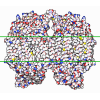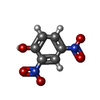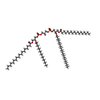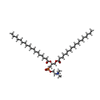+ Open data
Open data
- Basic information
Basic information
| Entry | Database: PDB / ID: 8j1n | ||||||||||||||||||
|---|---|---|---|---|---|---|---|---|---|---|---|---|---|---|---|---|---|---|---|
| Title | Structure of human UCP1 in the DNP-bound state | ||||||||||||||||||
 Components Components |
| ||||||||||||||||||
 Keywords Keywords |  MEMBRANE PROTEIN / UCP1 / SLC25A7 / thermogenin / SLC25 MEMBRANE PROTEIN / UCP1 / SLC25A7 / thermogenin / SLC25 | ||||||||||||||||||
| Function / homology |  Function and homology information Function and homology informationpurine ribonucleotide binding / cellular response to dehydroepiandrosterone / The fatty acid cycling model / The proton buffering model / oxidative phosphorylation uncoupler activity / mitochondrial transmembrane transport /  adaptive thermogenesis / adaptive thermogenesis /  cardiolipin binding / regulation of reactive oxygen species biosynthetic process / cellular response to cold ...purine ribonucleotide binding / cellular response to dehydroepiandrosterone / The fatty acid cycling model / The proton buffering model / oxidative phosphorylation uncoupler activity / mitochondrial transmembrane transport / cardiolipin binding / regulation of reactive oxygen species biosynthetic process / cellular response to cold ...purine ribonucleotide binding / cellular response to dehydroepiandrosterone / The fatty acid cycling model / The proton buffering model / oxidative phosphorylation uncoupler activity / mitochondrial transmembrane transport /  adaptive thermogenesis / adaptive thermogenesis /  cardiolipin binding / regulation of reactive oxygen species biosynthetic process / cellular response to cold / cellular response to fatty acid / response to temperature stimulus / cardiolipin binding / regulation of reactive oxygen species biosynthetic process / cellular response to cold / cellular response to fatty acid / response to temperature stimulus /  long-chain fatty acid binding / diet induced thermogenesis / proton transmembrane transporter activity / transmembrane transporter activity / brown fat cell differentiation / cellular response to hormone stimulus / proton transmembrane transport / response to cold / response to nutrient levels / cellular response to reactive oxygen species / GDP binding / positive regulation of cold-induced thermogenesis / long-chain fatty acid binding / diet induced thermogenesis / proton transmembrane transporter activity / transmembrane transporter activity / brown fat cell differentiation / cellular response to hormone stimulus / proton transmembrane transport / response to cold / response to nutrient levels / cellular response to reactive oxygen species / GDP binding / positive regulation of cold-induced thermogenesis /  mitochondrial inner membrane / regulation of transcription by RNA polymerase II / GTP binding / mitochondrial inner membrane / regulation of transcription by RNA polymerase II / GTP binding /  mitochondrion mitochondrionSimilarity search - Function | ||||||||||||||||||
| Biological species |   Homo sapiens (human) Homo sapiens (human)synthetic construct (others) | ||||||||||||||||||
| Method |  ELECTRON MICROSCOPY / ELECTRON MICROSCOPY /  single particle reconstruction / single particle reconstruction /  cryo EM / Resolution: 2.51 Å cryo EM / Resolution: 2.51 Å | ||||||||||||||||||
 Authors Authors | Chen, L. / Kang, Y. | ||||||||||||||||||
| Funding support |  China, 5items China, 5items
| ||||||||||||||||||
 Citation Citation |  Journal: Nature / Year: 2023 Journal: Nature / Year: 2023Title: Structural basis for the binding of DNP and purine nucleotides onto UCP1. Authors: Yunlu Kang / Lei Chen /  Abstract: Uncoupling protein 1 (UCP1) conducts protons through the inner mitochondrial membrane to uncouple mitochondrial respiration from ATP production, thereby converting the electrochemical gradient of ...Uncoupling protein 1 (UCP1) conducts protons through the inner mitochondrial membrane to uncouple mitochondrial respiration from ATP production, thereby converting the electrochemical gradient of protons into heat. The activity of UCP1 is activated by endogenous fatty acids and synthetic small molecules, such as 2,4-dinitrophenol (DNP), and is inhibited by purine nucleotides, such as ATP. However, the mechanism by which UCP1 binds to these ligands remains unknown. Here we present the structures of human UCP1 in the nucleotide-free state, the DNP-bound state and the ATP-bound state. The structures show that the central cavity of UCP1 is open to the cytosolic side. DNP binds inside the cavity, making contact with transmembrane helix 2 (TM2) and TM6. ATP binds in the same cavity and induces conformational changes in TM2, together with the inward bending of TM1, TM4, TM5 and TM6 of UCP1, resulting in a more compact structure of UCP1. The binding site of ATP overlaps with that of DNP, suggesting that ATP competitively blocks the functional engagement of DNP, resulting in the inhibition of the proton-conducting activity of UCP1. | ||||||||||||||||||
| History |
|
- Structure visualization
Structure visualization
| Structure viewer | Molecule:  Molmil Molmil Jmol/JSmol Jmol/JSmol |
|---|
- Downloads & links
Downloads & links
- Download
Download
| PDBx/mmCIF format |  8j1n.cif.gz 8j1n.cif.gz | 94 KB | Display |  PDBx/mmCIF format PDBx/mmCIF format |
|---|---|---|---|---|
| PDB format |  pdb8j1n.ent.gz pdb8j1n.ent.gz | 63.9 KB | Display |  PDB format PDB format |
| PDBx/mmJSON format |  8j1n.json.gz 8j1n.json.gz | Tree view |  PDBx/mmJSON format PDBx/mmJSON format | |
| Others |  Other downloads Other downloads |
-Validation report
| Arichive directory |  https://data.pdbj.org/pub/pdb/validation_reports/j1/8j1n https://data.pdbj.org/pub/pdb/validation_reports/j1/8j1n ftp://data.pdbj.org/pub/pdb/validation_reports/j1/8j1n ftp://data.pdbj.org/pub/pdb/validation_reports/j1/8j1n | HTTPS FTP |
|---|
-Related structure data
| Related structure data |  35928MC 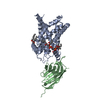 8hbvC 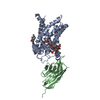 8hbwC M: map data used to model this data C: citing same article ( |
|---|---|
| Similar structure data | Similarity search - Function & homology  F&H Search F&H Search |
- Links
Links
- Assembly
Assembly
| Deposited unit | 
|
|---|---|
| 1 |
|
- Components
Components
| #1: Protein | Mass: 39468.367 Da / Num. of mol.: 1 Source method: isolated from a genetically manipulated source Source: (gene. exp.)   Homo sapiens (human) / Gene: UCP1, SLC25A7, UCP / Production host: Homo sapiens (human) / Gene: UCP1, SLC25A7, UCP / Production host:   Homo sapiens (human) / References: UniProt: P25874 Homo sapiens (human) / References: UniProt: P25874 | ||
|---|---|---|---|
| #2: Antibody | Mass: 15004.661 Da / Num. of mol.: 1 / Source method: obtained synthetically / Source: (synth.) synthetic construct (others) | ||
| #3: Chemical | ChemComp-DNF /  2,4-Dinitrophenol 2,4-Dinitrophenol | ||
| #4: Chemical | ChemComp-CDL /  Cardiolipin Cardiolipin | ||
| #5: Chemical |  Phosphatidylcholine PhosphatidylcholineHas ligand of interest | Y | |
-Experimental details
-Experiment
| Experiment | Method:  ELECTRON MICROSCOPY ELECTRON MICROSCOPY |
|---|---|
| EM experiment | Aggregation state: PARTICLE / 3D reconstruction method:  single particle reconstruction single particle reconstruction |
- Sample preparation
Sample preparation
| Component | Name: UCP1-sybody complex / Type: COMPLEX / Entity ID: #1-#2 / Source: MULTIPLE SOURCES |
|---|---|
| Source (natural) | Organism:   Homo sapiens (human) Homo sapiens (human) |
| Source (recombinant) | Organism:   Homo sapiens (human) Homo sapiens (human) |
| Buffer solution | pH: 8 |
| Specimen | Embedding applied: NO / Shadowing applied: NO / Staining applied : NO / Vitrification applied : NO / Vitrification applied : YES : YES |
Vitrification | Cryogen name: ETHANE |
- Electron microscopy imaging
Electron microscopy imaging
| Experimental equipment |  Model: Titan Krios / Image courtesy: FEI Company |
|---|---|
| Microscopy | Model: FEI TITAN KRIOS |
| Electron gun | Electron source : :  FIELD EMISSION GUN / Accelerating voltage: 300 kV / Illumination mode: FLOOD BEAM FIELD EMISSION GUN / Accelerating voltage: 300 kV / Illumination mode: FLOOD BEAM |
| Electron lens | Mode: BRIGHT FIELD Bright-field microscopy / Nominal defocus max: 1800 nm / Nominal defocus min: 1500 nm Bright-field microscopy / Nominal defocus max: 1800 nm / Nominal defocus min: 1500 nm |
| Image recording | Electron dose: 52 e/Å2 / Film or detector model: GATAN K3 BIOQUANTUM (6k x 4k) |
- Processing
Processing
| EM software | Name: PHENIX / Version: 1.18.2_3874: / Category: model refinement | ||||||||||||||||||||||||
|---|---|---|---|---|---|---|---|---|---|---|---|---|---|---|---|---|---|---|---|---|---|---|---|---|---|
CTF correction | Type: NONE | ||||||||||||||||||||||||
3D reconstruction | Resolution: 2.51 Å / Resolution method: FSC 0.143 CUT-OFF / Num. of particles: 709625 / Symmetry type: POINT | ||||||||||||||||||||||||
| Refine LS restraints |
|
 Movie
Movie Controller
Controller





 PDBj
PDBj

